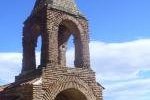Szucs Tamas
David Gareji Monasteries and Hermitage
David Gareji Monasteries and Hermitage (On tentative list)

Davitgareja (or David Gareji ) monastery is a nice day trip from Tbilisi, if you have your own vehicle. 4WD is not a must, but can be useful, specially on the last couple of kilometers. Theoretically you can get close to the site by public transport, as there are villages on the road to the monastery, but buses are quite erratic there, and you have to get some kind of private transport for the last part of the way. Organized trips to this region are also available in Tbilisi, but, as everywhere they are highly overpriced.
The road is OK up to Sagarejo, where you can see a big signpost. There turn right. On the following cca 10 km, the road is getting worse and worse. The first half is tar, but after the villages there is only a dirt road in various condition. We rented a Pajero so it meant no difficulties for us, and we have seen Russian tourists with a Lada Samara - so an urban car can do it. The landscape is astonishing - the barren semidesert of Southern Goergia, dotted with cows and sheep, witnesses of the unchanged ways of Caucasian animal husbandry in the last five thousand years.
Davitgareja is the end of the road. It is a real hermitage, where almost no influence of the outside secular world disturbs the contemplation. There is no entrance fee, and one of the monks, who speaks Russian sold us a guidebook in Russian and English. We had the chance to talk to one of the novices, an interesting person with a long background in the armed forces, who now wants to devout all his life to God. Ha told us, that there are less than ten monks and twice as much novices living actually in the monastery.
The monastery consists of several buildings and cave cells. Those cells, that are inhabited ar closed for the visitors, in the other parts you can walk around.
A brief description on what you can see there is in the documentation of the State party.
"The foundation of monastic centre in the first half of 6th century in the Gareji desert is connected with the name of one of the 13 Assyrian Fathers, St. David named Garejeli and his disciples Lukiane, Dodo and others. Along with the Lavra founded by St. David Garejeli, they laid the foundation of the monasteries of Virgin (Dodos Rka) and St. John the Baptist (Natlismtsemeli).
In Medieval times, Gareji desert with its rock-cut monasteries and magnificent murals containing the portraits of Georgian Kings, served as one of the most important monastic and pilgrimage centres of Georgia. It was a Royal monastery with a primary and figurative meaning. The Kings themselves patronised and took care of it.
In addition to churches, chapels and cells, there were numerous caves at Gareji for practical, everyday purposes; caves which served as barns, bakeries, smithies and housing for livestock. Terraces were constructed for agricultural purposes.
Some unique mural paintings are preserved in the Gareji monasteries, the oldest of which go back to the 8th century. Analysis of the surviving remains leads to the conclusion that till the end of the 10th century they only partially painted the interiors of Churches: usually just the apse and dome, but sometimes the northern wall as well. The most ancient mural paintings are found in the Dodos Rka Monastery, on an apse of one of the small Churches. Mural paintings of the 10th century are to be found in the Tsamebuli and Udabno Monasteries.
The period between the end of 10th to the beginning of 13th centuries was a golden age of Gareji monasteries. The Gareji School of painting developed in this period. One of the main features of this School is the representation of episodes from the life of St. David Garejeli in addition to the canonical scenes. The oldest example is to be found in the first layer of paintings of the main Church chapel of the Udabno Monastery. Another feature of the Gareji school of painting is an abundance of contemporary and realistic portraits of Royal personages. In some cases, they are the only images to have survived.
The turn of the 12th and 13th centuries witnessed the creation of the mural paintings of Bertubani Monastery, the finest achievement of the Gareji School. They are very impressive free style works and are distinguished by complete renditions of Life of the Virgin Mary."
Comments
No comments yet.
